Have you ever followed a recipe “to a T” only to have it end up a complete disaster? Yeah, you’re not alone. It’s happened to all of us… maybe even multiple times. ;) No matter how clearly a recipe is written, there will always be variables that can’t be accounted for and plenty of room for error. But don’t let that scare you! Cooking is a skill that must be learned and honed over time. That’s why we’re not all cooking like Julia Child after following our first recipe. After spending years troubleshooting recipes and answering questions from new cooks, I’ve compiled these 10 Tips for Recipe Success to help you navigate the unknown and hopefully prevent recipe disasters as you build your skills.
But if you do have a recipe disaster, learn from the experience! I like to think of recipe disasters a little like bad relationships. They may have felt like a total waste of your time and energy, but you’re bound to have learned something valuable along the way. ;)
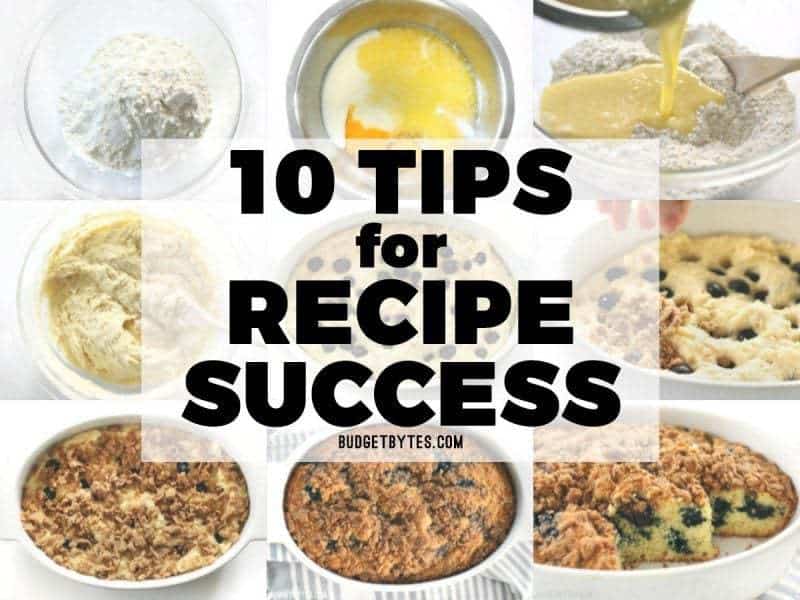
This post contains some affiliate links, which means that we make a small commission off items you purchase at no additional cost to you.
1. Read the Recipes from Beginning to End Before you Begin
Even if it’s a recipe you’ve cooked 10 times before, read through the entire recipe before beginning. This is probably the most overlooked step and one that even I admit to forgetting from time to time (and it ALWAYS ends up in an “oh crap!” moment). Giving a recipe a quick read-through helps prevent surprises, forgotten ingredients, and can help you form a mental game plan of how you’ll execute the recipe. On my site, I also suggest browsing through the step by step photos before beginning to cook, for an extra bit of disaster insurance.
2. Google Unfamiliar Words
We’re so lucky to have the internet and all of its information at our fingertips! If you come across a word in a recipe that you’re unfamiliar with, take a second to look it up. If it’s a cooking technique, chances are you’ll probably even be able to find a short tutorial video showing you exactly how it’s done and that’s like having a free, on the spot cooking class!
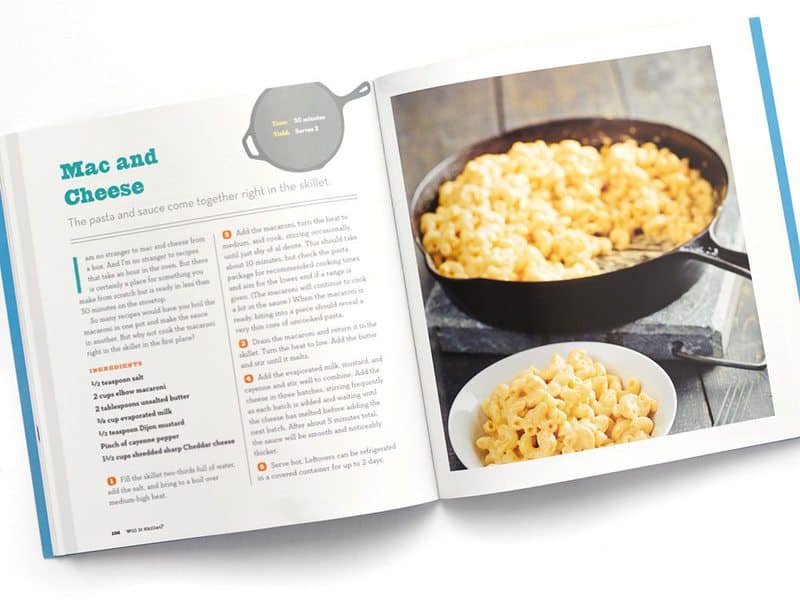
3. Pay Attention to How Ingredients are Listed
One thing that often trips people up is the term “divided,” as in “1/2 cup chopped nuts, divided.” When you see “divided” listed after an ingredient, this means the amount listed is the total amount used in the recipe, but you’ll use a portion of that amount in one step, and the rest later on. You can find out how much to use and when by reading the instructions (see tip #1!). For instance, with the chopped nuts example, the recipe may require you to stir 1/4 cup of the chopped nuts into a muffin batter and use the remaining 1/4 cup to sprinkle on top later. Another important designation is the placement of words like “chopped” or “diced.” If an ingredient is listed as “1 cup chopped walnuts” that means you measure one cup of nuts that are already chopped. If it is listed as “1 cup walnuts, chopped” this means that you measure 1 cup of whole walnuts, then chop them after measuring.
4. Read Reviews First
Almost every recipe website and blog has reviews, which can be extremely helpful. Always take reviews with a grain of salt, but look for trends like “this turned out too dry” or “I had to bake for an extra 15 minutes” so you can know which parts of the recipe to approach with caution, or decide if a recipe is too risky all together. I especially encourage this with blog recipes, which may not get the same rigorous testing as recipes from major food magazines or cookbooks. You don’t need to read them all, but at least browse through a few to get a feel for how the recipe performs “in the real world.”
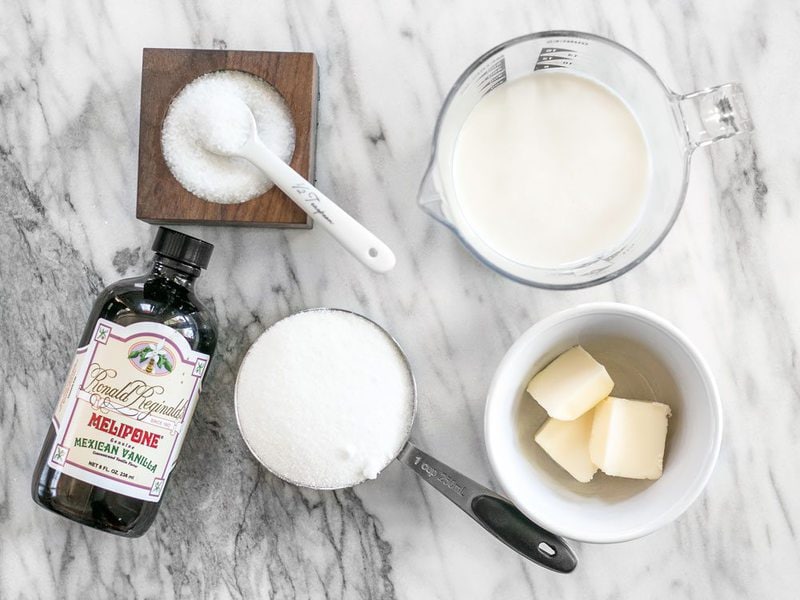
5. Prep Before you Cook
When you’re first learning to cook, it can be helpful to use a technique called “mise en place.” This French phrase simply means to gather all your ingredients and have them prepared (measured, peeled, diced, chopped, etc.) before you begin cooking. This method can take longer than prepping as you cook, but its a great way to make sure no details are missed and it can greatly reduce the stress of multi-tasking. With all your ingredients prepared ahead of time, all of your attention can stay on the hot food in the skillet/pot/oven as you cook so you can avoid burning, boiling over, or any other hiccup.
6. Start Small
If you’re new to cooking, try something simple first and work your way up. Don’t shoot for the stars on your first go. As I mentioned before, the process of cooking is full of all sorts of nuances and requires a great deal of intuition that you have to learn and build over time. If all you know how to do is boil water, start with a simple pasta dish. Try not to choose a recipe that has multiple techniques and ingredients that you’ve never used before. Try one new technique or ingredient at a time.
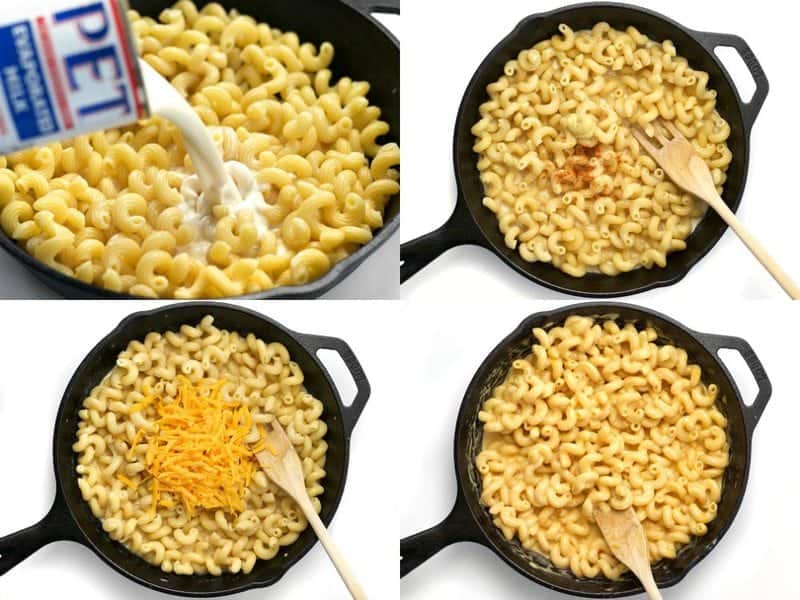
7. Test Recipes Before Special Occasions
There are an infinite number of variables involved with cooking and you want to avoid surprises, so it’s always good to give recipes a test run before big occasions or cooking for guests. It’s not unusual for a recipe to need slight tweaking for your unique mix of equipment and ingredients. Plus, you may just find that you don’t like a recipe as much as you expected from its description! :)
8. Use All Your Senses
Most recipes suggest cooking times and temperatures for each step, but it’s always wise to use your senses to tell you whether you need to increase heat, decrease heat, or move on to the next step. If a recipe says to sauté for five minutes, but you see and smell it beginning to burn sooner, STOP. Remove it from the heat and reassess the situation. I try to include sensory cues in my instructions when possible, to help you build your cooking intuition. A good example of sensory cues is when you toast rice in a skillet with a little bit of oil or butter, you’ll begin to smell a nutty aroma, the individual grains will begin to look translucent, and you’ll even hear a popping or crackling noise. I could simply tell you to toast the rice in a skillet with oil for 5 minutes, but if your range top runs hotter than mine or your cookware is thinner, this can change the timing. I can tell you to boil potatoes for ten minutes, but the only way to truly know they’re done is to test the texture by piercing them with a fork. Using your senses helps you really understand what is happening as you cook, and will build your intuition.
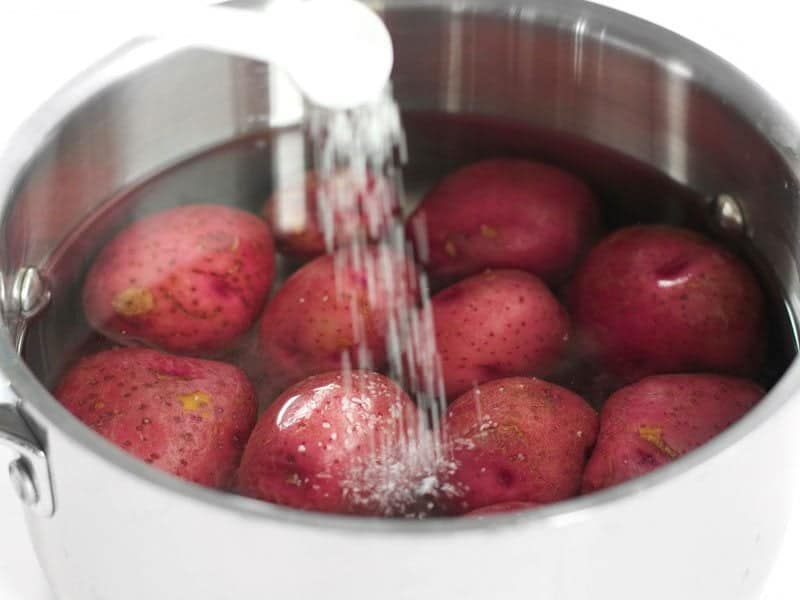
9. Taste As You Go
Speaking of using your senses, it’s very important to taste as you go. The one thing that varies the most in the cooking process is the taste buds of the individual, sensitivity to salt in particular. Try to taste the food as you go (avoiding raw meat and eggs) to make sure the food is seasoned to your palate. Tasting as you go will also help you learn how the flavor of herbs and spices change throughout the cooking process, allowing you to understand how and when to add them to customize recipes in the future.
10. Experiment With Caution
Every time you swap out an ingredient, no matter how small, it will change the flavor, texture, or both of the final recipe. Make sure you’re familiar with a recipe or cooking technique before you attempt to substitute ingredients. Read through those reviews to see if anyone else has already attempted the same substitution. Be aware that changing ingredients may also change the time or temperature needed to cook the dish. Making a recipe your own is a wonderful thing and I fully support customizing recipes to fit your needs, but make sure you do it with caution and with the knowledge that the outcome will be different from the original.
What are your favorite cautionary tips that you’d share with a new cook? Or something you’d tell yourself if you could go back in time to your first recipe? Share your wisdom in the comments below!


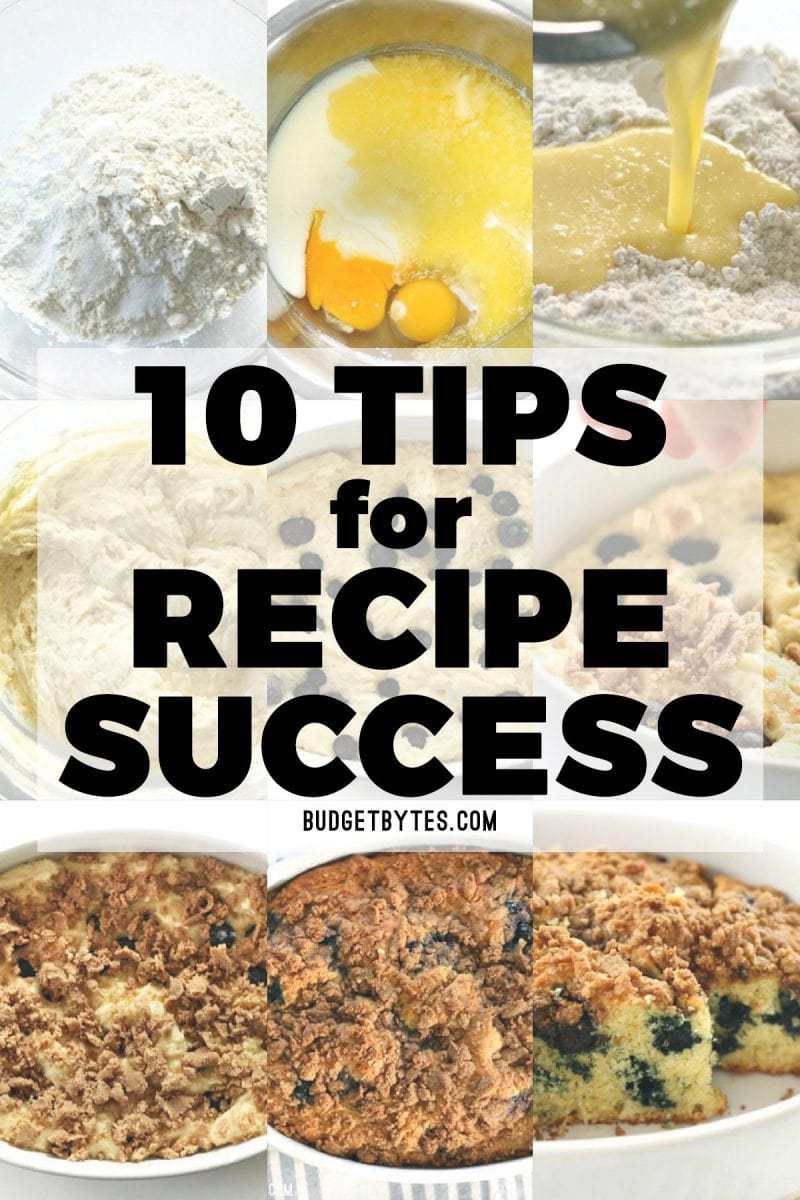
New bakers are afraid to try to bake.
They may live alone, nobody is watching what they do.
I tell them. Nobody saw that it didn’t work.
Toss the disaster and try again.
There are no witnesses to your mistakes.
Read the ten hints above
Stay calm
And try it again.
Always read the recipe
Get all ingredients out before you start
If for any reason you dont have an ingredient google “ what is a substitute for” and select one that fits in the context of the recipe
Be careful when you use the number of servings converters that are on some blogs. Especially for salt. If the printed recipe is for 2 servings and you want to go to eight servings you will probably ruin your food with four times as much salt.
When I was teaching my kids to cook, I have them go to the pantry and gather all of the ingredients in a flat box. Next I have them measure and prep and put each bowl on a sheet pan. Then they are able to start the cooking process and it is easier for them to see if they have added everything. I will say that these kids can now feed themselves and others.
My favorite story is I was at work and I usually made our Fourth of July Greek pasta salad and vegetarian baked beans the day before. We usually make about 20 servings of each dish. I was not looking forward to doing all of that after work. My granddaughter called me and said that she had made both of them. They were both perfect. I am so glad that she always helped me cook. She can do all of the secret family recipes to perfection now.
I think I shall employ this mise en place concept, as I am usually grabbing things as I go and my food in the pan is starting to overcook before I’ve finished chopping or prepping for the next step… Ev-er-y-time!!! I think I see the need for having to dirty up a lot of bowls or things to hold the prepped ingredients, and as someone without a dishwasher, that sounds extremely unappealing to me. But maybe just one larger platter can hold each item in a little pile. I’ll try that next time. Thanks for these tips! Very helpful!
Same, SK! Every time!! I personally include the gathering of equipment and kitchen tools I will need for a recipe into my “mis en place” routine — in addition to just preparing the ingredients and reading through the recipe before I begin cooking. If I have an idea of what I will need and put it all within arms reach, it seriously reduces the number of extra dishes I grab for this or that. I usually try to keep it to 1-2 bowls (combining ingredients that will be added together in the same bowl or reusing the same one at different steps) and love to use some little souffle cups I have for things like minced garlic or chopped herbs. You could also use the containers you’re going to store leftovers in later! ~Marion :)
It ALWAYS takes me longer to complete a dish than the recipes’ listed time estimates. I am considering doubling prep time for most recipes – especially when trying for the first time
Loved all these tips…wish I’d seen them decades ago when I was learning how to cook (teaching myself).
There is one issue that wasn’t covered and it’s a pet peeve of mine-from chefs and ‘recipe writers’.. Unmeasured ingredients as in, “!/4 onion, diced” or “1/4 chopped onion”. Now I buy #1’s at Walmart for 89 cents each and they are 3/4 of a pound or more. when my wife shops she buys small onions (in a net bag) that are 1/4 pound each. The same problem occurs with other aromatics like Bell Peppers, Celery and garlic.
I’ve sorted this out over years so I know what works and what we like, but it would be really great if some super smart chef (oh I don’t know-maybe someone from Nashville, TN?)
were to write up something for new cooks on some rules of thumb to help the beginners. Just sayin’.
Husband waited 30 years to tell me that he didn’t like corn in hamburger soup!
List all recipes and what cookbook they’re in. Or, name of cookbook and list the recipes & page numbers. Or, in the index of the cookbook highlight the recipes you like. Or, like me do all 3.
I accept that I’m slower than most doing recipe prep, but who can peal & slice 10 potatoes, 5 onions & slice 2 kielbasa sausages in 15 minutes? I ignore all prep times.
I do write OK, good or very good on the recipes. Then just cross out the ones husband doesn’t like.
Definately, list what changes I make.
great list! great reminders! Thank you.
Write the date on every recipe you try for the 1st time.
Stole that one from my mother, and there is nothing more powerful than running your fingers over ink and knowing you’ve been doing this same burger recipe for 10 years.
Regarding tip #9, you say to avoid tasting raw meat or eggs. There’s a way around this. For ground meat, make a small patty (about an inch or so) and cook it. Then you can taste it to see if you need to adjust seasonings for meatballs, burgers, or meat loaf. If you have chopped meat, same thing. Just cook a piece or two for tasting. It only takes a few minutes out of your time.
Smart idea.
In manufacturing in the aerospace industry we call this a “witness sample”. :)
My tip for trying something new is to take notes. I have serval recipes printed out just so I can use the back side for things I’ve tried that people liked or hated. I got good at trying new things but forgetting what changes I made. Once I started to write down the changes it helped me out a lot.
Great tips Tiffany!
“Another important designation is the placement of words like “chopped” or “diced.” If an ingredient is listed as “1 cup chopped walnuts” that means you measure one cup of nuts that are already chopped. If it is listed as “1 cup walnuts, chopped” this means that you measure 1 cup of whole walnuts, then chop them after measuring.”
I have been cooking for 13 years and have always wondered this!!! Thank you so much! You don’t even know how excited I am haha.
You’re so right!
Ditto!
The same thing goes for “sifted flour” vs. “flour, sifted.”
The flour one can make a huge difference! My great grandmother had a cookie recipe that was passed down without being written down. I was taught 4 cups flour, sifted. But the recipe was always temperamental. Adding extra liquid was essential, but how much worked was hard to judge. Then at some point it dawned on me to try 4 cups sifted flour. Bam! No need for extra liquid, and perfect cookies every time, since.
The same thing goes with “melted’. ie “1 cup butter, melted” or ”1 cup melted butter” Great site!
yes! Isn’t it amazing to learn something – I have been cooking for 50 + years…. I think I kind of knew this, but…. didn’t “KNOW” this. will be so helpful as I have one son moving home (22 years old) who is keener to learn more about cooking after a few years of University living…He will be miles ahead of me in reading recipes.
Thank you for such an informative food blog. While there are literally hundreds, if not more, food blogs out there, I do have to say I find yours to be so informative and on a level that every level of cook can understood and glean knowledge from. Your recipes I have tried so far are all ones I would keep in my “Definitely make again” list. I really appreciate the tips you give and have found that each one I find something in it that aids me in the kitchen.
Thank you and keep up the good work and great cooking!
Thank you Cherylynn!
Hello from the UK
We hve been metric for 20 years now. Although I was educated in the imperial system, I can only think metric now. Is it possible to include metric alongside you imperial system? Many thanks
Yes! I’m from Canada and it’s the same here. I can always ask Siri to translate, but I would love to save that step!
We get feedback about including metric units a lot, but unfortunately haven’t found a good solution for it yet. There are a lot of plugins and apps that already do automatic conversion (the recipe card that we use actually has that functionality), but while it sounds great in theory, it rarely works well in practice. There are many issues that prevent it from working properly, one of the main reasons being that often you need to not only convert from imperial to metric, but you also need to convert from volume to weight, which requires knowing the density of that particular ingredient. Other big issues include inconsistent ingredient formatting, the fact that we use both weight and volume ounces, and ingredients that contain both solid and liquid material, but the containers only list the “dry” weight. We’ve explored the issue a lot and I just don’t feel comfortable offering metric units unless I can manually remeasure and test each recipe with those units. Right now that’s not feasible, BUT hopefully in the future, when I have a full team, that’s a project we can put on the list. :)
Not sure how this could be treated but I have found more than once errors in a recipe. For example, a recipe for crock-pot potato soup called for eight pounds of potatoes. Yes, I bought them and brought them home. Regarded my crock pot and took a good look at the potatoes waiting to be peeled and opined, “Forget it!” Googled similar recipes and decided that was one recipe that I did not want to try. More than one recipe would advise in the “directions” to add a required item. But, nowhere in the list of ingredients was that item mentioned or its amount! So, my advice to the good folk sharing their recipes on their web sites to double check and/or proof read their recipe to save us a recipe disaster. Thank you for asking. :>)
This post has such perfect timing! I’m stressing our Easter menu (for 40!) and am trying to simplify things and am testing a few recipients this week! I don’t want any disasters! Thank you!!
Many great suggestions above! I would add: clean as you go. It’s not directly cooking related but it makes the whole process so much more fun, relaxed and less daunting. Taking natural pauses while cooking a meal to rinse prep dishes and put them in the dishwasher, wipe up spills, return excess ingredients to the fridge/pantry, and discard packaging and produce scraps means you have less mess in your way while you cook and less to clean up later. Much pleasanter to cook in a tidy (ish) kitchen than in one that looks like a bomb went off!
Especially in a small kitchen with limited counter space.
My favorite tip is to annotate all of your cookbooks, physical or digital. When you try a new recipe, mark the date and what your eaters thought of the recipe, and then note any substitutions or changes you made. Then, when you go to make that birthday cake two years later, you can find it again (p. 537 in Joy of Cooking? or was it p. 137 in the BHG cookbook?) and remember how it turned out (oh, the meringue didn’t set up right– I used more cream of tartar than the recipe called for).
Or you can highly instructions that are REALLY important, or note things that didn’t really matter.
Buy a oven thermometer to check heat. Had a oven that was lower heat and had to set temperature different!!! Know your oven!!!
Yes!
I really like my cooking thermometer with the extension. I monitor my bread or meat while cooking and have it programmed to beep when the correct temp is achieved. It means I can walk away from the oven (or stove top) and come back when it is perfectly done.
When I make a recipe I usually tweak it until I get exactly what I want. I also write down everything I put in it on a note with the recipe and if I decide to change some of it or add something I just make another note. I’m not as young as I once was and I forget things fairly easily. Then I have it in black and white and won’t forget anything.
Hi Beth,
Thanks so much for posting recipes that are within my technical skills and my budget as well as being yummy!
Just a heads up that the ads on your site have changed recently and every single time I visit I repeatedly see the same SPAM…… “FANTASTIC!! This is not a joke! 1,000,000th visitor. Our random winners selection system could choose you to win AN APPLE PRODUCT. CLICK HERE.”
The is obviously SPAM and I don’t appreciate it it, as I’m sure other visitors don’t either. In my opinion, it makes your website look unprofessional, which doesn’t gel with your overall vibe.
Anyways, keep up the great recipes and I look forward to your new creations!
Cheers,
Dandy
Thanks for letting me know, Dandy! We have filters set up to block those ads, but sometimes they get through. We don’t want those ads at all, but they can be very difficult to track and block. So, if you see one again, please take a screen shot and send it to me at [email protected] Thank you so much!
I love all these tips. I’ve been cooking just for myself this year and it is often such a struggle. Thank you so much for the tips.
One tip that I found out the hard way: if you don’t like how it smells, you won’t like how it tastes. This plays into tip number 8, “Use All Your Senses.” If something smells unappealing to you, it will not magically become appealing after you cook with it. I found this out by making a huge pot of soup with smoked paprika. The smoked paprika in the jar didn’t smell appealing, but I put it in anyway. The final soup was inedible to me. Now I know that I don’t care for smoked spices, but I wish I would have followed my nose and avoided ruining my soup! If something calls for smoked paprika, I just use regular paprika or leave it out altogether.
Great tip!
Notable exception, however: fish sauce. Smells disgusting, makes Thai curries amazingly delicious. Distrust your nose for that one.
Hahah, agree 100% :D
Oddly enough, my tastes have changed to the point that I now like smoked paprika a lot! So, new tip: be willing to try and try again things you haven’t liked in the past. Your tastes may change!
Great tip!
Excellent tips!!!
Yea usually I’m in such a hurry I don’t take time te read the recipe completely and well we know what usually happens👎
Adding to the idea of reading the comments, I would say ask a friend! Do you have that one coworker whose lunches you always envy? Ask them where they get their favorite recipes from, or send them a link to something you’re considering cooking to ask what they think or if they’ve made something similar. I’ve got a couple friends at work who loves to cook as much as I do and we’re constantly swapping tips, substitution ideas, and results of experiments. I’ve also got a few who are just learning to cook, and I equally love sharing my experiences with them.
I’ve learned that for anything soupy, stewy, or casseroley, you don’t have to follow the amounts or even the ingredients exactly. Those types of dishes are pretty forgiving.
Thanks, these all hold true with my experience. I’ve learned from a mix of cookbooks (and now blogs), tv cooking shows, advice (mostly from my mother – often when I’ve made a mistake and need to rescue the dish!) and of course, my own trial and error.
The only other tip I’d include, which ties in well with “prep before you cook” is “be patient and give yourself as much time as you can”. This also fits in with cooking – a lot of recipes I’ve used say things like “cook until softened” but don’t give you an expectation of how long that will actually take, or give a time that often works out as far too short for me.
Sometimes reviews on recipes can be super useful and other times… ha, it’s like they did a completely different recipe! But I agree that it does usually give a good idea on how well the original recipe works.
Great article! I have cooked for years and I still get confused by some recipes. I particularly like the “experiment with caution.” I cook enough that I understand the purpose of each ingrediant so I can switch things out but for a beginner it is difficult. I get quite frustrated with reviews in which the major ingredients were changed and then the writer complains about the outcome. My mother’s caution was “follow the recipe exactly the first time you make it. If you want to make changes the next time you at least know how the recipe works.”
Hey Danis, Your mum sounds like a very astute woman! That’s my motto as well and YES!!!!!! it frustrates me so much when comments and RATINGS are poor when the reviewer has changed ingredients – one or loads!!!
I got married when I was 18 and my cooking skills consisted of browning hamburger and boiling water.
5 kids and nearly 15 years later, here are my best tips:
Don’t be afraid to make mistakes.
Invest in decent tools. They don’t have to be top of the line, but some good tools (particularly knives/ cutting tools and pans) make any recipe more manageable.
Read a recipe for tools as much as ingredients. Nothing worse than getting 2/3 in and realizing you don’t have an immersion blender or stand mixer or zester. Or bread machine (true story, lol).
Be skeptical of any recipe with more than 4-5 ingredients that claims to be ready in less than 30 minutes.
It’s ok to buy ingredients prepped to your level. I can’t devein a shrimp to save my life, but I can carve a whole chicken. I buy tons of pre-chopped veggies at Sam’s.
Learn how to check for meat done-ness. I still struggle with this one!
The best tool I had as a beginner was a gift I was given when I got married. It was a cookbook by Kraft called Dinner on Hand, and it had a vast index of cooking times for veggies, as well as hundreds of recipe skeletons with suggestions for filling in with meat, sauce, and veggie combos that went together. It taught me basic cooking, and invaluable lessons about exchanging ingredients, what needed precise measurements (and what did not), and how to use the same handful of skills to create a lot of different tasting recipes.
All of these are great tips. I wish I’d had that Dinner on Hand book when I first got married.
Emily’s advice about investing in good quality tools is spot-on. One needn’t break the bank spending stupid amounts of money. Do invest in quality and take good care of your tools. I have pots, pans, and knives that have been in constant use for 35 years. They don’t look new and they still work flawlessly. Also, consider this: the right tool for the job. Sure, there are different ways of accomplishing a task. And a knife won’t zest a lemon.
One other thing. A word about mistakes. Mistakes happen. To everyone. I made a chocolate mousse using a recipe I’d made many times previously. I don’t know why, but this time the chocolate seized. Panic! I managed to get the lumps down to the size of lentils and called it Chocolate Chip Chocolate Mousse. It was a huge success.
Hahaha, I love that anecdote! :D
#5 was the biggest help for me when I first started.
Love these tips. I made pfefferneuse for my son-in-law at Christmas. Made them for over 20 years so didn’t worry. I realized too late I’d forgotten to add the baking soda. Oops. The cookies were more dense and not salty enough. They were edible but he didn’t like them; the one cookie he’ll eat and I messed them up due to not going through the recipe “one more time” before starting.
Another tip for older cooks: Go find your reading glasses and use them! Don’t guess you are reading correctly just because you’ve made the recipe so many times!
These are so helpful! I totally agree with the “experiment with caution” part. For me it’s always best to follow the recipe closely the first time I make it so I know what I’m working with. But after that, one of my favorite parts of home cooking is being able to (over time) customize a recipe to exactly fit my tastes. Eventually you end up with a set of things you can make that are *exactly* as spicy as you want, *exactly* as cheesy, etc. Being able to experiment the right way comes with time and skill but it’s one of the big advantages of being a home cook :)
Great tips! I especially like “Experiment with Caution” because I normally don’t have all of the ingredients for recipes that I find so I sometimes substitute with what I have on hand. And it can be tricky! Thanks!
A nice Cliff Notes version of cooking wisdom.
Over the years I have learned that it is very important for me to make notes either directly on the recipe that I printed out or in the book or perhaps even in a separate notebook that I keep for such things. We learn from our own adjustments and or mistakes and writing them down make sure that we will do better next time
This is also my #1 tip when following a recipe. I leave notes that say, “next time add….” or “try reducing _____ by 1 tablespoon”, etc. If I have changed up the recipe, I write down the new contents, measurements, cook time etc.
Mise en place is also a great way to break up a recipe into smaller chunks of time. For instance, if I have extra time in the morning, I’ll chop veggies for dinner and put them back in the fridge, ready for when I get home from work. Chopping, measuring, mixing dry ingredients, or mixing sauces can all be done ahead of time with a lot of recipes. Coming home to make a recipe with mise en place already set up is like having your own sous chef! Doing recipes one part at a time can also make them less intimidating and be helpful for those who have trouble standing for long periods of time.
I love that!
Great tips! I’ve always wondered why some recipes were listed as “walnuts, chopped” vs “chopped walnuts” but figured it was just a style preference!
Me too!
Really useful tips.Especially mac and cheese, next time will be adding new ingredient or new technique in my recipe.
“Another important designation is the placement of words like “chopped” or “diced.” If an ingredient is listed as “1 cup chopped walnuts” that means you measure one cup of nuts that are already chopped. If it is listed as “1 cup walnuts, chopped” this means that you measure 1 cup of whole walnuts, then chop them after measuring.”
I never knew of this distinction! Thanks!
Awesome tips! I just want to let you know that your food recipes are very reliable compared to many that are listed online. You’re thorough in your directions and actually explain why you do certain things a certain way so it’s really easy to learn cooking tips and tricks from your recipes as well. Thank you for all your work and I can’t wait to try more of your recipes this year! xx
Thank you!
These are all great tips – I wish I’d had them, and this website, when I had started cooking a few years ago!
(small grammar note: rather than sensory queues, I think the term would be sensory ~cues~? though I do like the image of smells and sights lining up all nice and orderly!)
LOL, you’re right! Thanks for catching that! :D
Great tips. Thanks for sharing.
Something else worth noting is that not all substitutions are created equal. Some things you can substitute in recipes without any major difference in quality (i.e. a neutral flavored oil in lieu of melted butter), some things can be substituted with noticeable but relatively minor differences in the results/flavors (i.e. water in lieu of stock, dried spices instead of fresh, etc), and some substitutions will result in an end product that is wholly different (and probably completely inferior) than the original (i.e. substituting skim milk for heavy cream). Do research!!!!! Many recipes can easily be adapted to fit the limitations of your pantry, diet, or budget, but be smart about it and have a game plan for how you’re going to make the recipe work. I’m not a content creator, but as an avid home cook, it can be mindboggling to see the sort of substitutions/alterations that amateur cooks make to recipes, and then complain about their finished product not being comparable to the recipe. (I literally once saw a comment on a food blog’s recipe complaining about the finished product, when instead of baking it in the oven @350 for 30 minutes, the commentor had microwaved it for 30 minutes instead. My jaw dropped.)
WOW. hahah
Great advice! I shared it with my boyfriend who is still learning to cook. I think you meant “cue” instead of “queue” though.
Doh! Thank you for catching that!